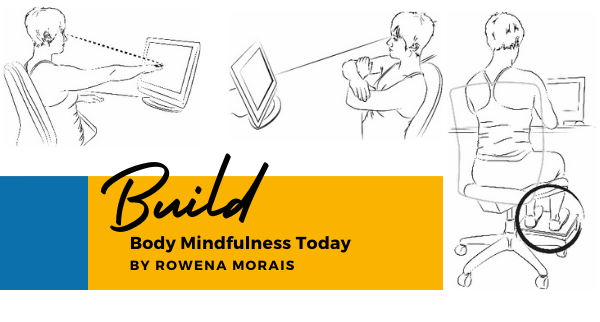
Why It Is Important to Develop Self Care Competencies
A meetup I ran last Saturday brought a painful realisation home for me. Exercise is important not only for its touted benefits of muscular strength, endurance, improved cardiovascular system and energy to run our day. Regular exercise is also important for the prevention of chronic pain and illness.
Let’s simply talk about general movement as a goal.
Exercise does not have to be limited to the common ones such as running, biking, swimming or weightlifting. Let’s simply talk about general movement as a goal.
I’d like to look specifically at the urban, white-collar screen-intensive jobs many of us have. Our increasingly sedentary lifestyle is worsened by a host of other factors: overuse of the computer, excessively long work hours, finding it hard to take breaks when getting into flow during tasks, as well as expectations around work and deliverables. These come together in a powerfully negative way, worsened by the remote work many of us are undertaking as a result of the COVID-19 pandemic.
Inactivity increases the chance of obesity, heart disease, stroke, type 2 diabetes, and a range of cancers. Our long work hours are bearing down on us, mentally and physically. More stress, less free time and poor work-life balance increase health risks.
We need, now more than ever, to make the shift from a reactive to proactive approach to the work-related aches, pain and musculoskeletal discomfort associated with long hours of computer work.
Australians pay for about 17 percent of total health expenditure directly through out of pocket expenses. An average of $1,235 per person, which leads me to my point – the importance of building body and postural mindfulness as a core work skill. We need, now more than ever, to make the shift from a reactive to proactive approach to the work-related aches, pain and musculoskeletal discomfort associated with long hours of computer work.
According to Dr Elizabeth Kirk, founder of Beyond Ergo, this means developing new ergo and self-care competencies which includes increased awareness and knowledge of risks. It also means implementing the work skills, behaviours and physical conditioning exercises needed to manage a multidisciplinary range of issues and risks associated with our health, wellbeing and productivity.
In the recent Thrive meetup, we discussed a few self-care considerations to increase your comfort and productivity and reduce musculoskeletal pain and the chance of developing a career-limiting overuse injury. I would like to share some of Liz’s workstation set-up tips with you:
Let’s first adjust your chair.
You should be able to rest your forearms (but not your elbows) on the table with relaxed shoulders. If your feet do not touch the ground, add a footrest.
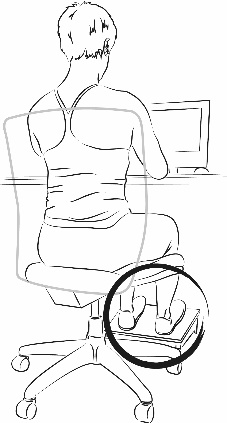
Now your screen height.
The centre of your screen should be about shoulder height. The easiest way to judge this is to place your arms parallel to the floor and point to the screen. You should be pointing to the centre of your screen.
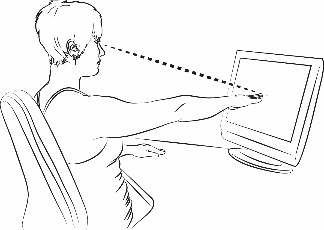
This screen adjustment also applies to your laptop.
Laptops should not be used flat on the work surface for more than two hours a day. This common posture seems normal because we see it so often.
But notice that:
- your head is jutting forward to look closely at the screen
- your neck is in compression, which can lead to fatigue, headaches, poor concentration, increased muscle tension and even injury to the vertebrae over time
- it can even limit the ability to turn your head
- you will quickly feel the difference on your back and neck by lifting your laptop using books and binders and adding an external keyboard and mouse.
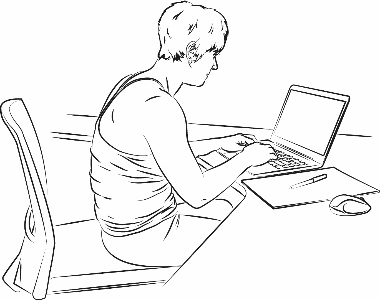
The mouse!
We tend to lean slightly towards the side we use the mouse, especially if we are using a long keyboard. This leads to neck, back and shoulder pain on that side. Try swapping your mouse to the other side for a while. It takes a little practice, but you will soon get the hang of it!
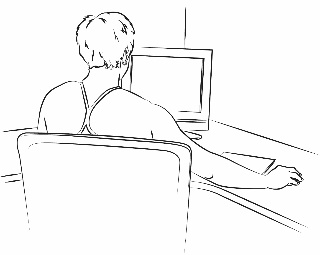
Have you heard about your Primary Reach Zone?
This zone is rarely included in the ergo checklists, yet is very important, especially if you are a small person. Ideally, your keyboard and mouse should fit within the width of your shoulders. This ensures you can work in a neutral posture with shoulders relaxed and elbows tucked into your side. Long keyboards push your mouse too far to the right causing you to maintain an awkward and soon painful posture for long periods.
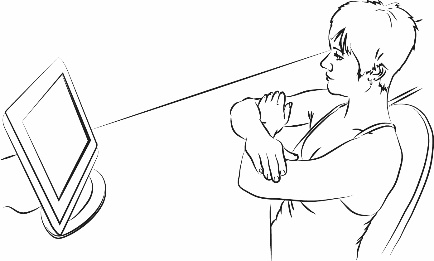
During the meetup, we tried the Roll-Reset-Relax, to release the tension that builds up in your neck and shoulders and help you reset your posture back to relaxed and neutral.
See a video demonstration and download the instruction sheet on this. Making this one dynamic stretch a regular part of your day can decrease upper back discomfort by up to 50%.
Do you get headaches while working at the computer?
Try adjusting the monitor brightness to about 60% and avoid using bright colours in documents you constantly view. These are both very tiring on your eyes.
To increase awareness around the health risks and self-care competencies needed in our twenty-first century, mobile, screen-intensive and increasingly sedentary working world, your training goal must go beyond simply providing more information on the topic.
It must also demonstrate and provide staff with an opportunity to take action. It must ensure training is translated into actionable work skills that will increase comfort and productivity, decrease pain and chance of injury and reduce labour costs and exposure to workers compensation claims.
Further, empowering staff with skills to proactively address risks associated with the development of overuse injuries will help support staff’s mental health.
No one wants to work in pain. Helping staff build skills to reduce this additional burden will positively affect their career aspirations as well as their mental and physical health, wellbeing and productivity. This is why building body and postural mindfulness early and developing the right ergo and self-care are now essential work skills leading to positive outcomes for the staff and the business.
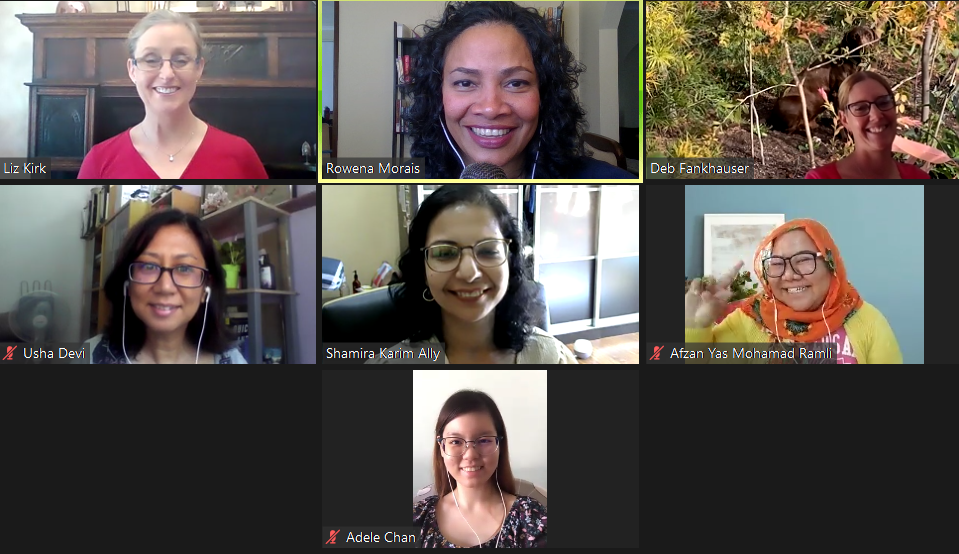

Find out more about Thrive meetups or sign up for an upcoming meetup.
If you are interested in discovering more about the Beyond Ergo training, join Liz’s free mini Ergo and Self-Care Virtual workshop. If you would like additional detail on the business case for introducing holistic ergonomics and wellness training, you can download Liz’s Position Paper
Dr Liz Kirk is the founder of Beyond Ergo, which provides a unique new tier of training created through PhD research, informed by industry needs, and specifically designed to manage one of the industries’ major labour costs: the high rates of absenteeism, stress, attrition due to work-related musculoskeletal pain and discomfort associated with long hours of screen use.
Programme Director at VerticalDistinct.com, a media and learning organisation, Rowena Morais provides support through curated learning, communication and content development. She supports HR and Tech professionals through digital resources and internationally accredited programmes delivered across APAC and the Middle East. Author of Build a Body of Work, Rowena was Founding Editor of HR Matters Magazine in Malaysia for eight years. A LinkedIn profile writer, ghostwriter and editor, she helps organisations and senior executives with communication, branding and content development. Over the last decade, she has been helping people refine their LinkedIn profiles and digital presence. Rowena runs meetups for HR folk and career women in both Kuala Lumpur and Canberra. She runs her boutique marketing and communications consultancy, Digital Confluence, from Canberra. Invited to the TEDx stage twice, Rowena delivers workshops on leveraging LinkedIn and has a Skillshare class, Build Influence through LinkedIn. You get two months premium membership free when you sign up on Skillshare where you can take her class and more – visit https://skl.sh/2KqhEfp
Images courtesy of Liz Kirk